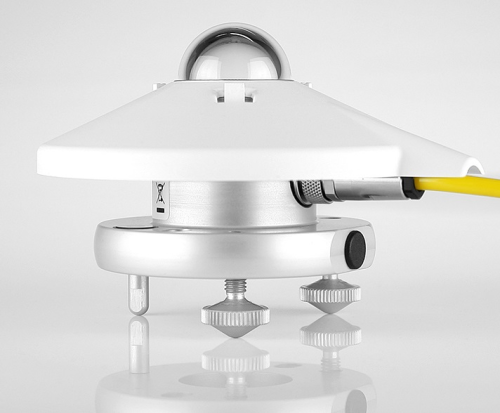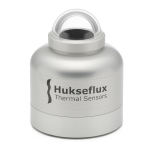
ほとんどのCampbell Scientificデータロガーとの互換性






概要
Kipp & Zonen 製の CMP3-L は、太陽スペクトルの全範囲にわたって日射を監視する ISO-second-class の全天日射計です。この日射計はミリボルト信号を生成し、Campbell Scientific データロガーによって直接測定されます。CMP3-Lは、さまざまな気象学的用途に日射測定を提供することができます。
続きを読む利点と特徴
- センサの温度を下げる白いスナップオン式遮光シールド付き
- 反転させて反射日射を測定
- 直射日光下、植物のキャノピー、曇り空、人工照明の下での測定を提供
- 気泡水準器と水平調整ネジが付属し、別途水平調整ベースを用意する必要がなく、設置が簡単
- 安定性推定に使用される日射データの提供に最適
- サーモパイルを保護し、水が転がり落ちるドーム
- 屋内外で連続使用できる設計
イメージ



詳細
仕様
| センサ | ドームで保護された黒色サーモパイル |
| 測定の説明 | 太陽スペクトルの全範囲の太陽放射を監視 |
| 測定範囲 | 300 ~ 2800 nm |
| 最大放射照度 | 2000 W/m2 |
| 感度 | 5 ~ 20 µV/W/m2 |
| 動作温度範囲 | -40° ~ +80°C |
| 温度依存性 | ±5% (-10° ~ +40°C) |
| 非直線性 | < ±2.5% (0 ~ 1000 W/m2) |
| 傾斜応答 | < ±2% (1000 W/m2 の場合) (±80°) |
| ISO クラス | クラス C (セカンドクラス) |
| ドーム直径 | 3.2 cm (1.3 in.) |
| 幅 | 7.9 cm (3.1 in.) |
| 高さ | 6.7 cm (2.6 in.) |
| 重量 | 600 g (1.2 lb) 10 m (32.8 ft) ケーブルの場合 |
互換性
注意: 以下は代表的な互換性情報を示しています。互換性のある製品や互換性のない製品をすべて網羅したリストではありません。
Data Loggers
| 製品 | 互換性 | 注意 |
|---|---|---|
| CR1000 (リタイア) | ||
| CR1000X (リタイア) | ||
| CR300 (リタイア) | ||
| CR3000 (リタイア) | ||
| CR310 | ||
| CR350 | ||
| CR6 | ||
| CR800 (リタイア) | ||
| CR850 (リタイア) |
互換性に関する追加情報
取り付け
ドキュメント
よくある質問
CMP3-Lに関するよくある質問の数: 10
すべて展開すべて折りたたむ
-
ドームが破損した場合は、Campbell Scientific または Kipp & Zonen に連絡してドームの交換についてご相談ください。修理にはセンサを Kipp & Zonen に送る必要があります。
-
これは、センサのドームがサーモパイルよりも暖かい状況によって発生する可能性があります。ほとんどのユーザーは、夜間に小さなマイナス値を確認します。一般にオフセットと呼ばれるこの値は、センサのパフォーマンスを監視する上で重要になる場合があります。
-
いいえ。CMP3-L は、Campbell Scientific データロガーなどのデータ収集システムに接続する必要があります。
-
CMP3-L には、入射太陽放射の代表的な量に相当する小さなアナログ電圧を生成するパッシブ サーモパイルが搭載されています。差動アナログ入力端子を介して CMP3-L のリード線を Campbell Scientific データロガーに接続することをお勧めします。
-
すべてのセンサに異なるケーブル終端オプションがあるわけではありません。特定のセンサで利用可能なオプションは、センサ製品ページの注文情報エリアの 2 つの場所で確認できます。
モデル番号
ケーブル終端オプション リスト
センサが –ET、–ETM、–LC、–LQ、または –QD バージョンで提供されている場合、そのオプションが利用可能かどうかはセンサモデル番号に反映されます。たとえば、034B は 034B-ET、034B-ETM、034B-LC、034B-LQ、および 034B-QD として提供されています。その他のすべてのケーブル終端オプション (利用可能な場合) は、センサ製品ページの注文情報エリアの「ケーブル終端オプション」の下にリストされています。たとえば、034B-L 風力発電セットは、034B-L 製品ページの注文情報エリアに示されているように、–CWS、–PT、および –PW オプションで提供されています。
注意: 新しい製品が在庫に追加されると、通常は複数のモデル番号を作成するのではなく、1 つのセンサモデルの下に複数のケーブル終端オプションをリストします。たとえば、HC2S3-L には、HC2S3-LC モデルではなく、CS110 に接続するための –C ケーブル終端オプションがあります。
-
Campbell Scientific のセンサのほとんどは、ユーザー指定のケーブル長を示す –L として提供されています。センサが –LX モデル (「X」は他の文字) としてリストされている場合、そのセンサのケーブルの長さはユーザー指定ですが、固有のシステム用の特定のコネクタで終端されます。
- -LC モデルには、ET107、CS110、または廃止された Metdata1 に接続するためのユーザー指定のケーブル長があります。
- -LQ モデルには、RAWS-P 気象ステーションに接続するためのユーザー指定のケーブル長さがあります。
センサのメイン モデル番号の後に –L または –LX の指定がない場合、センサのケーブル長は設定されています。ケーブル長は、製品の注文情報の説明フィールドの末尾に記載されています。たとえば、034B-ET モデルの説明は、「ET ステーション用 Met One Wind セット、67 インチ ケーブル」です。ケーブル長が設定されている製品は、デフォルトでバラ線で終端されます。
ケーブルが特定のシステム用の特別なコネクタで終端されている場合、モデル番号の末尾でそのシステムを指定します。たとえば、034B-ET モデルは、ET107 システムのセンサを 034B として指定します。
- –ET モデルは、ET107 気象ステーション用のコネクタです。
- –ETM モデルは ET107 気象ステーション用のコネクタですが、交換部品を購入するときに便利な特別なシステム マウントも含まれています。
- –QD モデルは、RAWS-F クイック展開ステーション用のコネクタです。
- –PW モデルは、PWENC または配線済みシステム用のコネクタです。
-
多くの Campbell Scientific センサは、さまざまなケーブル終端オプションで利用できます。これらのオプションには次のものがあります。
- –PT (–PT w/Tinned Wires) オプションはデフォルトのオプションであり、他のオプションのように製品ラインには表示されません。ケーブルは、データロガーに直接接続するバラ線で終端します。
- –C (–C w/ET/CS110 コネクタ) オプションでは、ケーブルは CS110 電界メータまたは ET シリーズ気象ステーションに接続するコネクタで終端します。
- –CWS (–CWS w/CWS900 コネクタ) オプションでは、ケーブルは CWS900 シリーズ インターフェイスに接続するコネクタで終端します。CWS900 シリーズ インターフェイスに接続すると、センサをワイヤレス センサー ネットワークで使用できるようになります。
- –PW (–PW w/Pre-Wire Connector) オプションでは、ケーブルは事前に配線されたエンクロージャに接続されるコネクタで終端します。
- –RQ (–RQ w/RAWS コネクタ) オプションでは、ケーブルは RAWS-P 常設リモート自動気象ステーションに接続するコネクタで終端します。
注意: ケーブル終端オプションの選択肢はセンサによって異なります。たとえば、センサには選択可能なオプションがまったくないか、複数ある場合があります。特定のセンサに必要なオプションがリストされていない場合は、Campbell Scientific に問い合わせてサポートを受けてください。
-
IR 放射の損失のため、ほぼすべてのサーモパイル計器には通常、負のオフセットがあります。このオフセットは夜間に最も目立ち、ゼロではなく小さな負の値が読み取られます。この同じオフセットは日中にも存在しますが、太陽信号が大きいため目立ちません。
もう 1 つの一般的な問題は、計器の水平調整です。サーモパイル計器の水平調整では、コサイン応答が正しくないため、直接ビーム成分にエラーが発生する可能性があります。太陽が地平線に近い場合、角度が非常に浅いため、これらのエラーはより顕著になります。
-
LP02-L は Hukseflux 社製のセンサで、CMP3-L は Kipp & Zonen 社製のセンサです。どちらのセンサも、ISO 分類の Second Class 日射計に適合しています。
-
ワイヤレス センサ インターフェイスと互換性のあるセンサをワイヤレス ネットワークに組み込むには、CWS900 シリーズ ワイヤレス センサ インターフェイスと、それを構成するための A205 CWS-PC インターフェイスが必要です。
Privacy Policy Update
We've updated our privacy policy. 詳細はこちら
Cookie Consent
Update your cookie preferences. クッキーの設定を更新する

